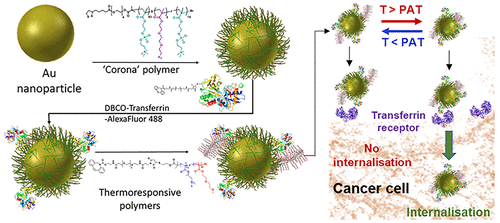当前位置:
X-MOL 学术
›
Bioconjugate Chem.
›
论文详情
Our official English website, www.x-mol.net, welcomes your
feedback! (Note: you will need to create a separate account there.)
Switching of Macromolecular Ligand Display by Thermoresponsive Polymers Mediates Endocytosis of Multiconjugate Nanoparticles
Bioconjugate Chemistry ( IF 4.0 ) Pub Date : 2018-02-26 00:00:00 , DOI: 10.1021/acs.bioconjchem.7b00704 Edward J. Sayers 1 , Johannes P. Magnusson 2 , Paul R. Moody 1 , Francesca Mastrotto 2, 3 , Claudia Conte 2 , Chiara Brazzale 3 , Paola Borri 4 , Paolo Caliceti 3 , Peter Watson 4 , Giuseppe Mantovani 2 , Jonathan Aylott 2 , Stefano Salmaso 3 , Arwyn T. Jones 1 , Cameron Alexander 2
Bioconjugate Chemistry ( IF 4.0 ) Pub Date : 2018-02-26 00:00:00 , DOI: 10.1021/acs.bioconjchem.7b00704 Edward J. Sayers 1 , Johannes P. Magnusson 2 , Paul R. Moody 1 , Francesca Mastrotto 2, 3 , Claudia Conte 2 , Chiara Brazzale 3 , Paola Borri 4 , Paolo Caliceti 3 , Peter Watson 4 , Giuseppe Mantovani 2 , Jonathan Aylott 2 , Stefano Salmaso 3 , Arwyn T. Jones 1 , Cameron Alexander 2
Affiliation

|
Ligand-mediated targeting and internalization of plasma membrane receptors is central to cellular function. These types of receptors have accordingly been investigated as targets to facilitate entry of diagnostic and therapeutic constructs into cells. However, there remains a need to characterize how receptor targeting agents on nanoparticles interact at surface receptors and whether it is possible to control these interactions via exogenous stimuli. Here, we describe the switchable display of the iron-transporting protein, transferrin (Tf), at the surface of thermoresponsive polymer-coated gold nanoparticles and show that internalization of the coated nanoparticles into target cells changes across temperature ranges over which transferrin is expected to be sterically “hidden” by an extended polymer chain and then “revealed” by polymer chain collapse. The switching process is dependent on the numbers of transferrin molecules and thermoresponsive polymer chains attached and whether the assay temperature is above or below the transition temperatures of the responsive polymers at the nanoparticle surfaces. Significantly, however, the control of internalization is critically reliant on overall nanoparticle colloidal stability while the thermoresponsive component of the surface undergoes conformational change. The data show that the cell entry function of complex and large biomolecule ligands can be modulated by polymer-induced accessibility change but that a simple “hide and reveal” mechanism for ligand display following polymer chain collapse is insufficient to account for nanoparticle uptake and subsequent intracellular trafficking.
中文翻译:

热响应聚合物切换高分子配体显示介导多共轭纳米粒子的内吞作用。
配体介导的质膜受体靶向和内在化对细胞功能至关重要。因此,已经研究了这些类型的受体作为靶标,以促进诊断和治疗构建体进入细胞。然而,仍然需要表征纳米颗粒上的受体靶向剂如何在表面受体上相互作用以及是否有可能通过外源性刺激来控制这些相互作用。在这里,我们描述了铁转运蛋白转铁蛋白(Tf)的可切换展示,在热响应性聚合物包覆的金纳米颗粒的表面上发现,包覆纳米颗粒进入目标细胞的内化在整个温度范围内发生变化,在该温度范围内,转铁蛋白预计会在空间上被延伸的聚合物链“隐藏”,然后由于聚合物链的塌陷而“露出” 。转换过程取决于运铁蛋白分子和连接的热响应性聚合物链的数量,以及测定温度是高于还是低于纳米颗粒表面响应性聚合物的转变温度。然而,重要的是,内部化的控制关键取决于整个纳米粒子的胶体稳定性,而表面的热响应性成分则发生构象变化。
更新日期:2018-02-26
中文翻译:

热响应聚合物切换高分子配体显示介导多共轭纳米粒子的内吞作用。
配体介导的质膜受体靶向和内在化对细胞功能至关重要。因此,已经研究了这些类型的受体作为靶标,以促进诊断和治疗构建体进入细胞。然而,仍然需要表征纳米颗粒上的受体靶向剂如何在表面受体上相互作用以及是否有可能通过外源性刺激来控制这些相互作用。在这里,我们描述了铁转运蛋白转铁蛋白(Tf)的可切换展示,在热响应性聚合物包覆的金纳米颗粒的表面上发现,包覆纳米颗粒进入目标细胞的内化在整个温度范围内发生变化,在该温度范围内,转铁蛋白预计会在空间上被延伸的聚合物链“隐藏”,然后由于聚合物链的塌陷而“露出” 。转换过程取决于运铁蛋白分子和连接的热响应性聚合物链的数量,以及测定温度是高于还是低于纳米颗粒表面响应性聚合物的转变温度。然而,重要的是,内部化的控制关键取决于整个纳米粒子的胶体稳定性,而表面的热响应性成分则发生构象变化。











































 京公网安备 11010802027423号
京公网安备 11010802027423号